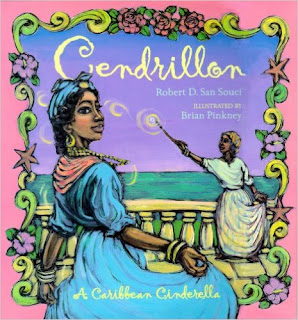Written by: Robert D. San Souci
Illustrated by: Brian Pinkney
Cendrillon is a Caribbean version of the classic Cinderella tale is "loosely based on the French Creole tale 'Cendrillon'" (author's note) and draws upon many details from the island of Martinique. While the tale contains all of the familiar Cinderella elements of the poorly-treated, working girl figure through Cendrillon's character, the story is uniquely told from the godmother's point of view. This change in perspective introduces an additional voice to the familiar story for readers to explore.
Beginning with a look at the illustration, Pinkney uses his unique medium of painted scratchboard to create distinctive artwork that creates a strong feeling of Caribbean life. The use of full-bleed pages filled with rich, vibrant colors- especially blues and greens- transport the world to island life by the sea. The intricate scratch-marked lines within every detail on the page allow the paintings to depict movement and life, while the swirling patterns within the water and clouds make the sea-breeze come to life. All of these artistic choices create a strong sense of Caribbean life and match the text well in setting the scene for readers.
With respect to the text, San Souci inserts many authentic French Creole words into the text, as is evident in the book's first sentence which references the "Mer des Antilles," to immerse readers in the Caribbean culture. As San Souci knows his audience is not comprised solely of French Creole speakers, he defines the words in context by placing English synonyms around them, and then provides further details within a user-friendly glossary in the back of the book. Caribbean life is also depicted through the text describing the attire that the women wear to the ball, including turbans and gold jewelry. The details presented within the illustrations skillfully parallel the textual descriptions to create a cohesive product.
The shift in point of view to the godmother, as opposed to the classic focus on the Cinderella character's perspective, provides readers with fresh eyes on the tale and new emotions to connect with. While the godmother does provide humorous commentary at various points in the story, I think this shift makes the story more relatable to older readers, as it demonstrates the love between godparent and godchild figures from the adult perspective. By presenting this viewpoint, more sentimentality is introduced, as is visible through the godmother's assertions of her love, such as: "When I held that bebe in my arms on her christening day, I felt such love! And I saw love returned from her sweet brown eyes." I do think this book would be an entertaining read aloud for younger readers and an exciting way to be exposed to a few new words in French Creole, and is a great addition to any Cinderella studies because of its unique perspective and additional, minor changes made throughout the work.

No comments:
Post a Comment